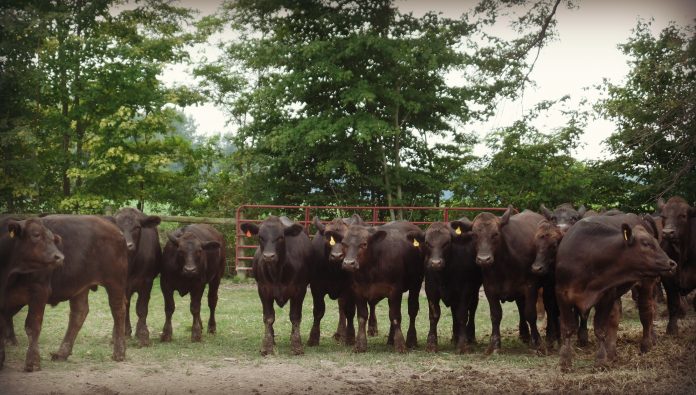Consumer demand for locally produced food is sky high. A USDA Local Food Marketing Practices Survey identified over 167,000 operations across the nation selling food direct to consumers, retail, institutions and intermediaries; their sales accounted for $8.7 billion dollars in revenue. Ohio contributed $1.8 million to total direct food sales in 2015.
9.3 percent of U.S. livestock producers market products through direct sales channels. Beef, poultry, lamb, goats, pork, aquaculture and specialty animal products accounted for $648 million dollars in earnings according to the 2012 USDA Census of Agriculture.
Challenges of moving meat from farm to fork
There is a great opportunity to market local meat in Ohio and the region, but the opportunity comes with challenges. Raising animals for market takes a lot of time and effort. Farmers and ranchers have difficulty finding additional time to manage processing and distribution of meat products for direct sales.
Many farmers struggle to brand and package products in a way that appeals to consumers. They point out that agriculture, not marketing, is their area of expertise. Farmers may need to educate customers on the benefits of buying local meat. It can be a challenge to convince customers who are used to buying a tube of beef at a big box store for a fraction of the price and flavor that local meat is a better buy.
Securing a federally inspected meat processor is a major barrier to local meat production. The National Agricultural Statistics Service found the number of federally inspected cattle slaughter plants declined 12 percent between 2001 and 2013. As a result, producers have difficulty planning production to satisfy demand. They face long wait times; which may push an animal beyond target market weight range or maturity. Often farmers are forced to transport livestock long distances to slaughter.
Small operations may not produce a sufficient volume of meat to sell to restaurants, institutions and intermediaries. The alternative, selling local meat in low volume channels, may not generate enough revenue to support their livestock operation.
The cooperative business model is a solution
A cooperative is a business entity, like a partnership or limited liability company. However, cooperatives differ from other business structures because they are owned and controlled by the farmers that use their services. Other business entities aim to maximize profits; cooperatives aim to serve member-owners.
Cooperatives benefit farmers and ranchers in many ways. Multiple small operations may form a marketing cooperative to gain access to larger markets. Ohio farmers formed the Buckeye Valley Beef Cooperative to do just that. Founding member Adam Bolender said, “We had all fed out freezer beef in the past. We wanted to merge together to make larger scale sales to grocery stores and butcher shops- that was the main idea behind starting a co-op.” Today consumers can purchase Buckeye Valley Beef Cooperative products at five grocery stores, local butcher shops and direct from the farmers.
Scott Farms is a member of United Producers Inc., a large regional livestock marketing co-op. UPI honors members’ commitment to producing high-quality animals with special sales and premium marketing agreements. Erik Scott is a preferred member and delegate of UPI co-op. Erik shared, “United Producers gives us an opportunity to step into markets that we may not have access to otherwise. It connects us with sale outlets across the country, and that connects us to the world market.”
Learn how a cooperative can help your farm achieve goals at the Farm Science Review. Attend Local Meat and the Cooperative Business Model workshop, Thursday, September 21, 2017, at 11 a.m. at the Small Farm Center. The Small Farm Center is located at the corner of Beef St. and Corn Ave.
Resources
- “2015 Local Food Marketing Practices Survey”, United States Department of Agriculture.
- “2012 Census of Agriculture”, United States Department of Agriculture.
- “Overview of the United States Cattle Industry” (June 2016). United States Department of Agriculture. National Agricultural Statistics Service.











To protect the animals from cruelty, suffering. I can’t believe this is going on and the owners of farms allow this behavior. And why do employees hit the poor animals do they get a kick out of it.. There should be a stop to this. I know people want to eat but lets be humane about it. I know it’s a lot of money so why don’t we have a corporation come in and structure it properly and make everybody happy. NO MORE ABUSE